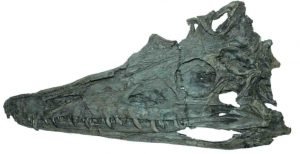
The skeleton of a small, short-snouted reptile found in China was recently identified as the oldest known member of the phytosaurs — an extinct group of large, semi-aquatic reptiles that superficially resembled the distantly-related crocodylians and lived during the Triassic Period, approximately 250 million years ago to 200 million years ago.
Virginia Tech researchers led the team that re-evaluated and re-classified the animal, Diandongosuchus fuyuanensis, which had previously been labeled as a poposauroid, a group of animals more closely related to crocodiles.
The shape of the animal’s head, shoulder, and skeleton bones is what gave away the animal’s linkage to the phytosaurs, according to Michelle Stocker, lead author and assistant professor of geosciences in the College of Science. After seeing a photo of the fossil in a paper published in 2012, she and other co-authors met in China in 2015 to re-examine the bones. Their findings were published in Scientific Reports April 10.
The fossil, which is older than other phytosaur fossils by about 5 million years, fills a critical gap in scientists’ understanding of how the animal evolved. The short snout and small body size suggest that the features the species is most known for — a long snout and large body size — evolved later than previously thought. A long snout is useful for predatory endeavors like reaching, snapping, and biting.
“So much of our study of the fossil record is about filling in the gaps in our knowledge of how animals came to look as they do or live where they are, and Diandongosuchus does that for phytosaurs. We’re never done filling in those gaps,” said Stocker.
“Early members of these Triassic reptile lineages are appearing where they’ve been predicted for years. Now we have the fossils,” said Nesbitt.
Reference:
Michelle R. Stocker, Li-Jun Zhao, Sterling J. Nesbitt, Xiao-Chun Wu, Chun Li. A Short-Snouted, Middle Triassic Phytosaur and its Implications for the Morphological Evolution and Biogeography of Phytosauria. Scientific Reports, 2017; 7: 46028 DOI: 10.1038/srep46028
Note: The above post is reprinted from materials provided by Virginia Tech.










